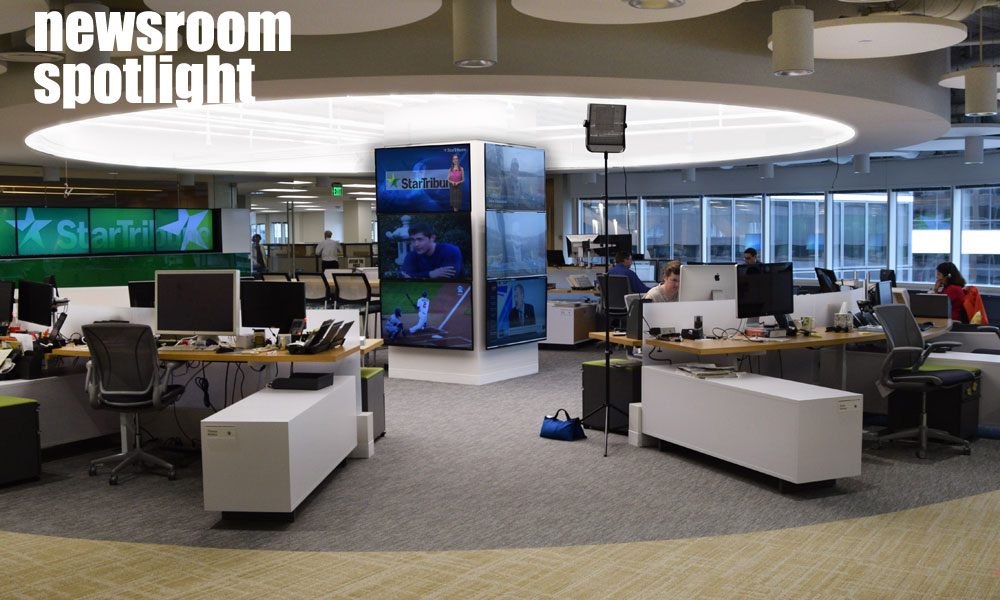Editor’s Note: This Q&A is part of “Newsroom Spotlight,” a series of conversations with journalists about what’s going on in their newsrooms and the media industry. The interview excerpts have been lightly edited and organized for clarity. The interviewer interned with the Star Tribune in Minneapolis and Washington.
When Rene Sanchez rose to become the top editor of the Star Tribune in 2013, he said, “We’re on a good course,” and since then has steered Minnesota’s largest news organization toward digital true north.
Recently the Star Tribune rolled out a redesigned website, which Sanchez told readers will “better showcase photography, video and graphics.”
The Star Tribune’s newsroom, staffed by about 250 journalists, turns out about 100 stories or blog posts a day, heeding Sanchez’s directive to engage with residents around the greater Minneapolis region in new ways.
Sanchez, a native of New Orleans, started his journalism career with his hometown paper, The Times-Picayune. After serving as a Washington Post reporter for 17 years, he joined the Star Tribune in 2004.
AJR: What key experiments are currently underway in your newsroom?
Rene Sanchez: Well, we are pushing harder on more ambitious digital storytelling, and we are doing more video than we’ve ever done before. We are expanding our digital newsletters, another way for people to get our content or link back to our website for it. We’ll probably be experimenting this year with more digital-first content as well.
AJR: How does the Star Tribune newsroom approach packaging stories for the web?
Sanchez: There’s a lot more planning around all of that now. When we have an ambitious story, it almost always comes with some vital digital aspects, such as video or interactive graphics, that are important to delivering the story to our readers.
AJR: And how often do you see the newsroom doing big packages?
Sanchez: Oh, it’s hard to quantify. Those take an incredible amount of work, so I think in an average year, we’re probably doing those about six to 10 times a year.
AJR: How is your newsroom approaching storytelling for mobile devices?
Sanchez: We’re trying to get more aggressive on mobile. Our readership there is growing. Last fall, we took a lot of steps to polish and expand our mobile platform. First and foremost, by trying to make sure that the mobile site had what we call “content parity” with our website and print edition. If you go to the website to read and see photo galleries, that same content is available to you now on the mobile site.
AJR: Are there any media companies out there that you think are disrupting the news media landscape? And if so, how and why?
Sanchez: One thing I’ve noted lately is the new push in some newsrooms to produce really smartly themed digital newsletters, in which some of the best of the content the newsroom produces is being pushed out that way to readers. I think the Washington Post, for example, is doing intriguing things with its newsletters.
AJR: Can you please describe the most innovative thing your newsroom has done in the past year.
Sanchez: One of the most innovative things we’ve done in the last year might be the yearlong print and digital project that we undertook on the big risks and consequences emerging nationally from the huge collapse of bee colonies – the pollinators for a big part of the food chain. We had never tried to be so ambitious with the digital storytelling for that one, by mingling video and photography and graphics with the story, free of other links to content and ads. It was very difficult but also very rewarding. Now the digital tools are there for us to do that.
AJR: What emerging technologies or storytelling methods are you trying to learn more about because they have the potential to impact news in your newsroom?
Sanchez: We’re taking more advantage of new story tools digitally such as Storify when a big story breaks, and doing more live blogging of news events, too.
AJR: Could you describe the audience development efforts underway in your newsroom, including the number and types of staff hired, new departments created, teams formed, etc.
Sanchez: Deepening the engagement of our digital audience has become a priority. In the last few months we’ve converted some pre-existing jobs into new digital jobs that are really focused on that goal. We have three new jobs in the newsroom devoted in one way or another to that. We’re at a point now where no one really in this newsroom or any other can really sit on its hands and just presume that readers who want to be informed and want to track the news are just going to come to the home page.
AJR: How does your newsroom use analytics to make daily coverage decisions?
Sanchez: They are a good tool to use, but you can’t be so utterly chained to them that it warps your news judgment. The way a day unfolds, it’s important to see the content that readers are gravitating to, so we meet twice a day now. We actually begin each of those meetings by looking at what’s happening with our readership on all the digital platforms.
AJR: Can you tell me a little bit about your newsroom’s social media efforts. Are all reporters required to use social media to promote their stories?
Sanchez: Requirement is not the right word. We don’t walk around with a clipboard checking how many times people tweet a day. On some beats, that’s an essential, important part of every day, on others less so, so we don’t have a quota, and I don’t think we ever will, but obviously that’s become an important point of action on many beats.
AJR What are your most successful efforts involving obtaining user-generated content for your website?
Sanchez: We have a group of community bloggers called “Your Voices.” It’s a destination on our website where we enlist voices in the community from different walks of life or they’re civically engaged in one way or another, and they blog for us. Sometimes they blog reacting to the news, reacting to issues in the Twin Cities. Some of them have really developed a very loyal and consistent audience that’s big.
AJR: Does your news organization hold events? If so, what types as far as news engagement and innovation?
Sanchez: The company does hold events; some of them are built from our features content. For example, there’s one event that we’ve had for years called Talking Volumes. It features prominent authors from around the country. We intend to do many more of these, now that we have a new location for our newsroom that’s in the heart of downtown Minneapolis. The site will allow us to hold lunchtime type events on hot topics in the Twin Cities and Minnesota. We did our first one a few weeks ago at the start of the baseball season and the Minnesota Twins’ fortunes, and it drew several hundred people at lunch – a great sign of the potential.
AJR: On a scale of 1-5, how optimistic are you about the future of news? (5 would be very optimistic; 1 would be not optimistic at all.)
Sanchez: Oh, that’s an easy one, that’s a 5 because there’s never been a time when citizens in the community I think crave news as much as they do now – and actually crave it in a way that they can be confident that it is real, that it is fair-minded, that it is deeply reported by professionals. There’s a lot of junk out there, and I think people have come to realize that for all the great benefits of the Internet, sometimes what’s there, looking like news, is actually junk, and it’s not held to the highest standards of reporting and community interests – or any standards. So I’m very optimistic that if we do our jobs well, that the readers will stick with us and they’ll stick with us either on their phones, or on their laptops or their iPads, or they’ll continue to buy the paper. There’s so many different ways to access our content. If it’s strong and if it’s fair minded and complete, I’m very optimistic that they’ll keep having a strong interest in seeing it every day.









